Abstract
Aromatic amines are urinary bladder carcinogens in man and induce tumors at a number of sites in experimental animals including the liver, mammary gland, intestine, and bladder. In this review, the particular pathways involved in the metabolic activation of aromatic amines are considered as well as the specific DNA adducts formed in target and nontarget tissue. Particular emphasis is placed on the following compounds: 1-naphthylamine, 2-naphthylamine, 4-aminobiphenyl, 4-acetylaminobiphenyl, 4-acetylamino-4'-fluorobiphenyl, 3,2'-dimethyl-4-aminobiphenyl, 2-acetylaminofluorene, benzidine, N-methyl-4-aminoazobenzene, 4-aminoazobenzene, and 2-acetylaminophenanthrene.
Full text
PDF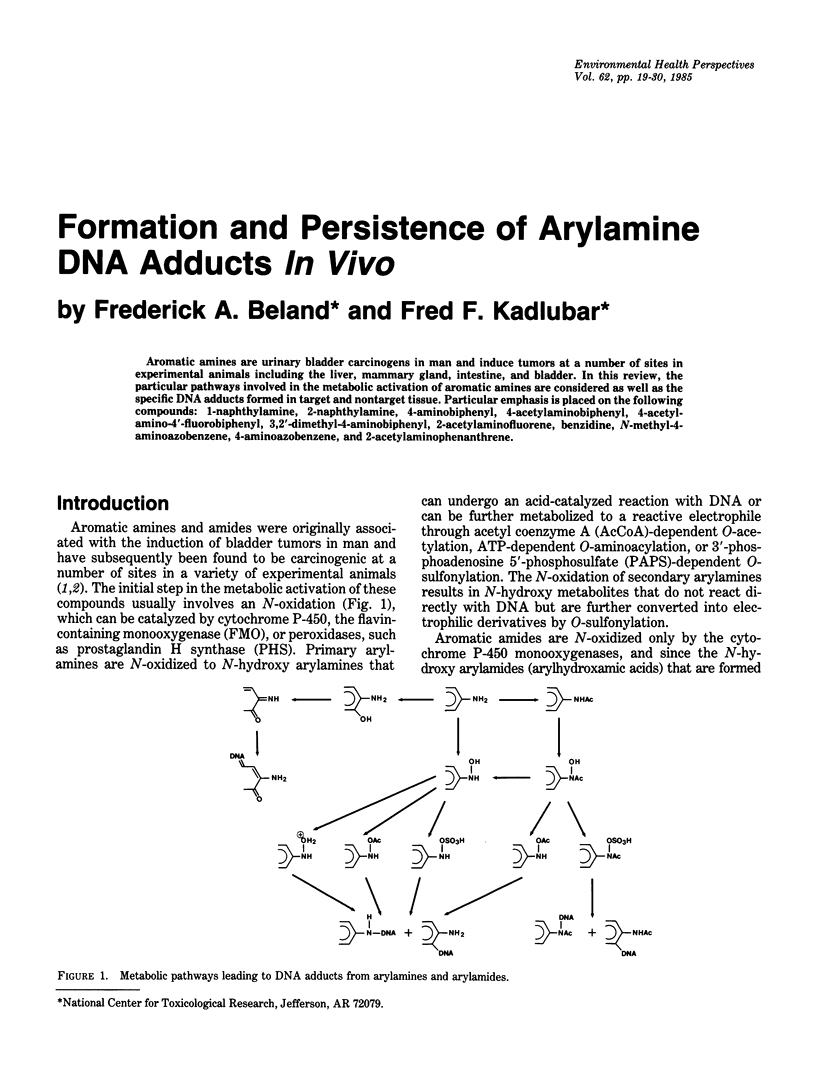
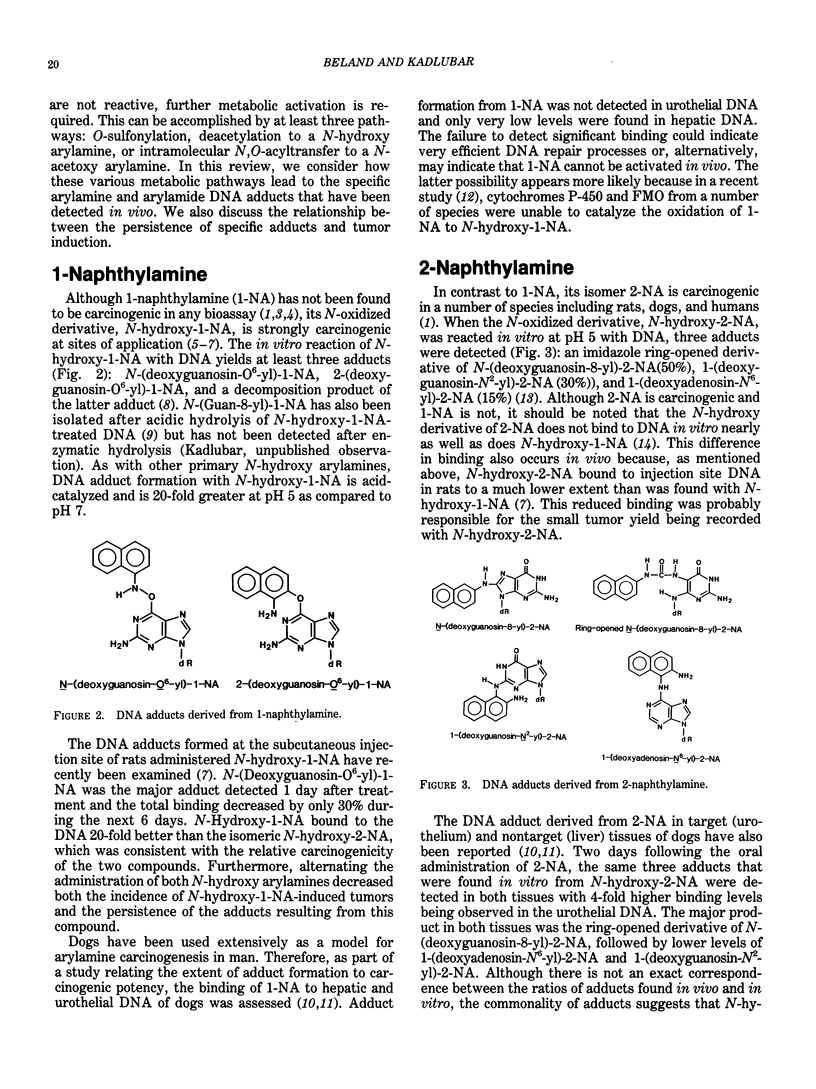

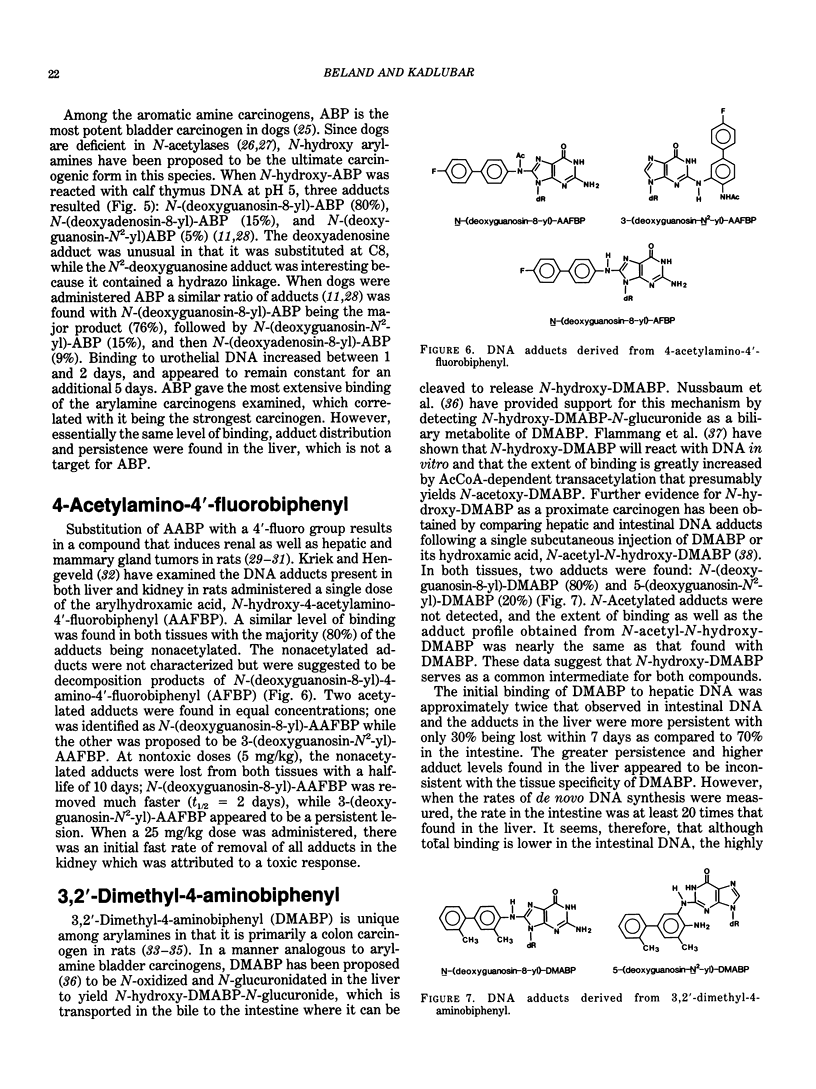

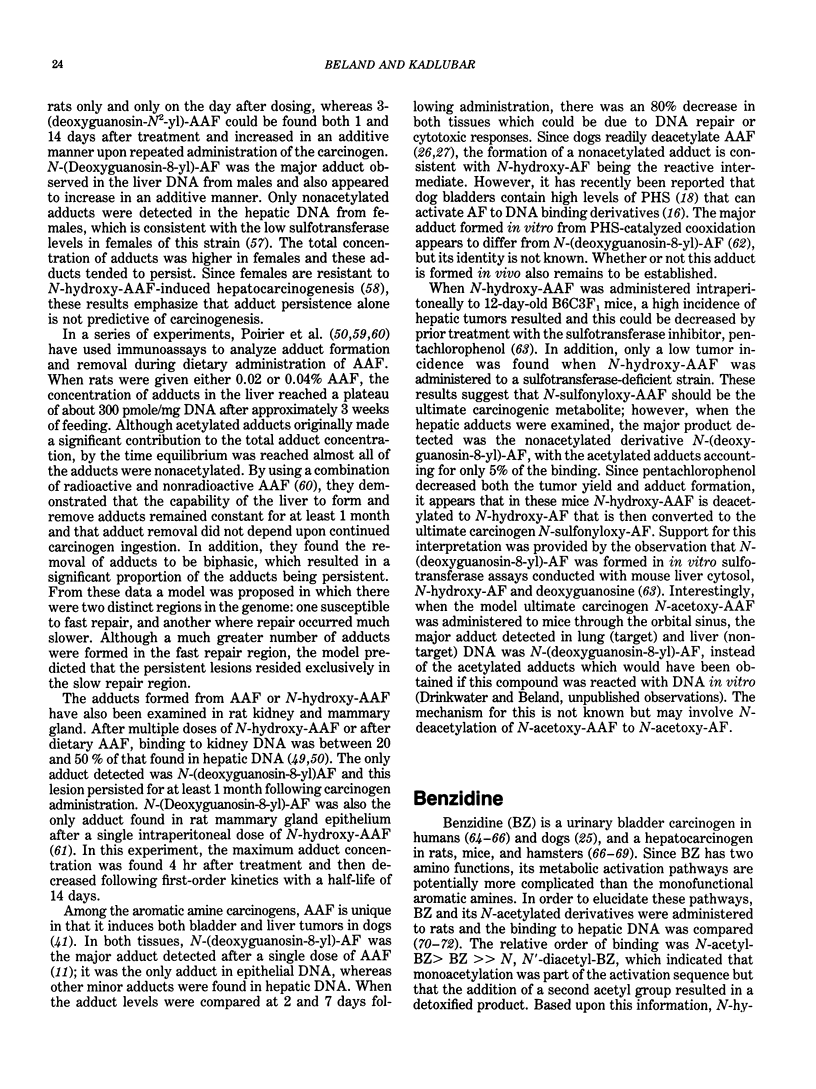
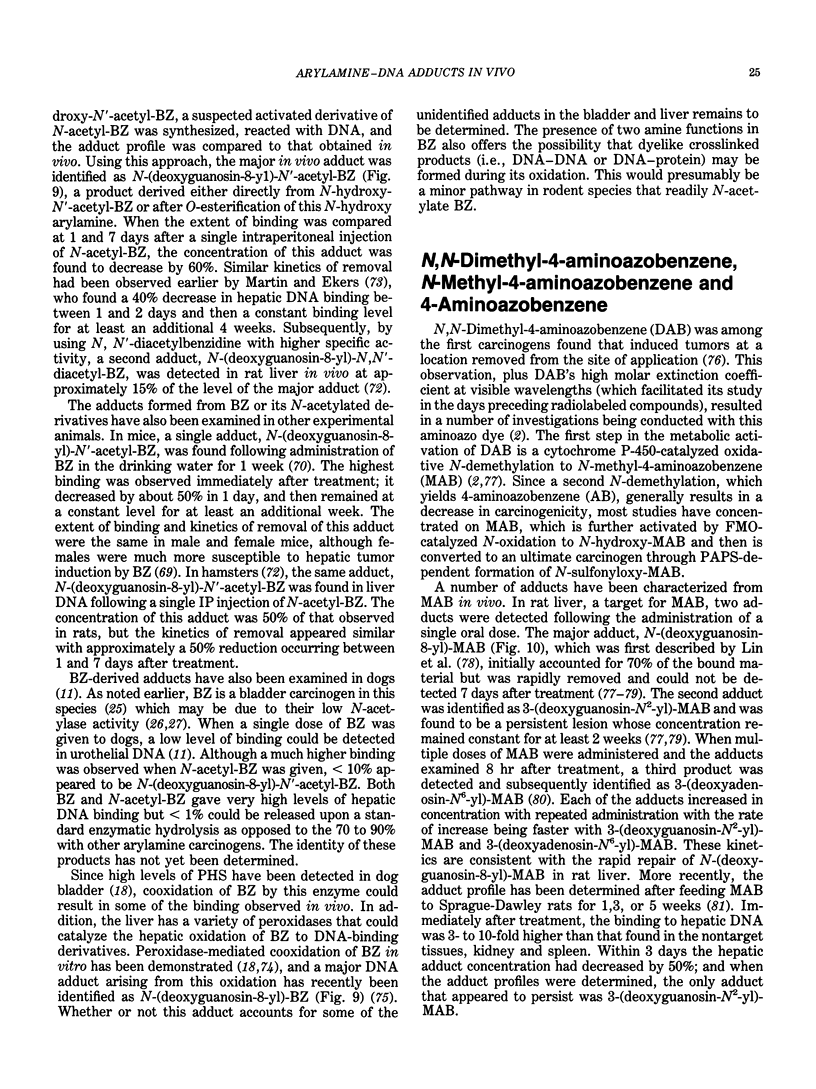
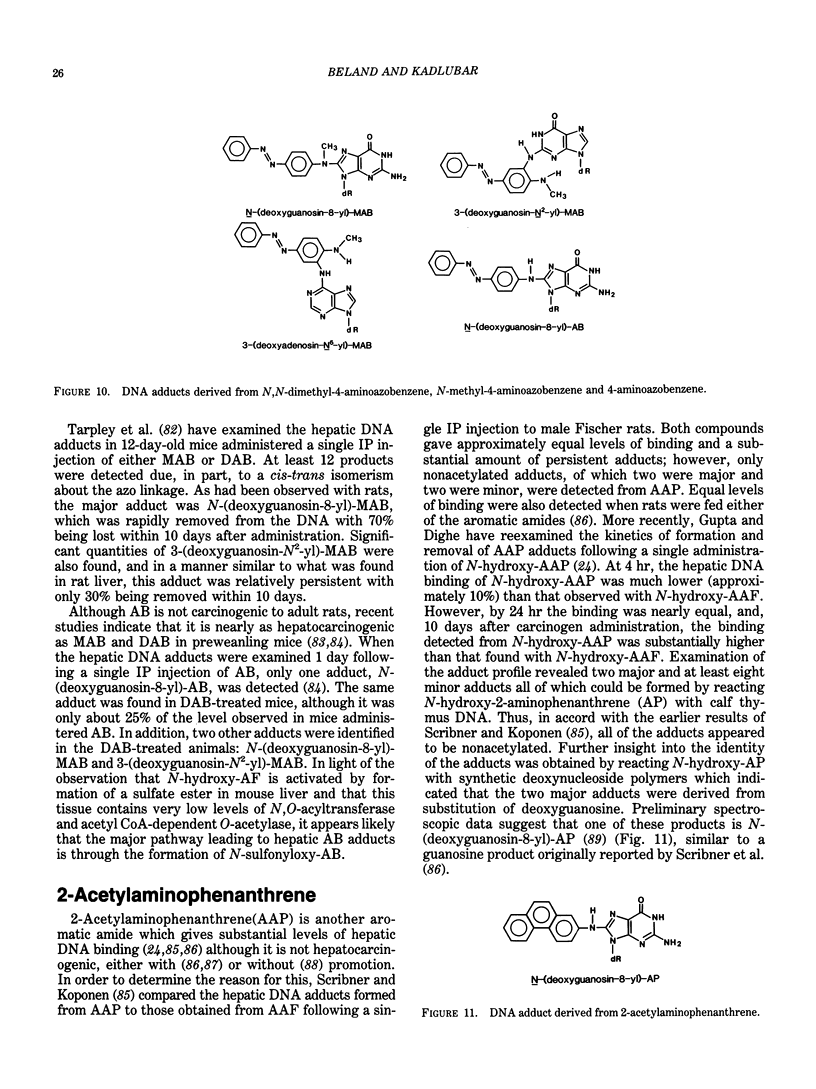
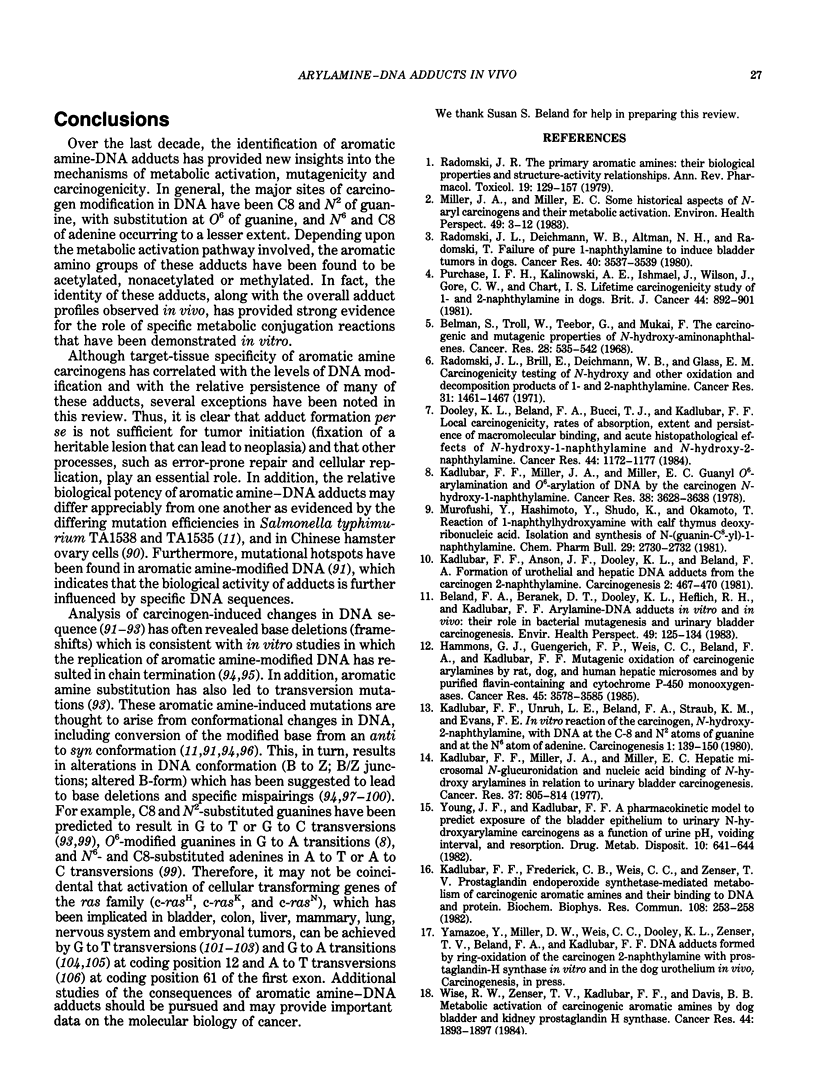
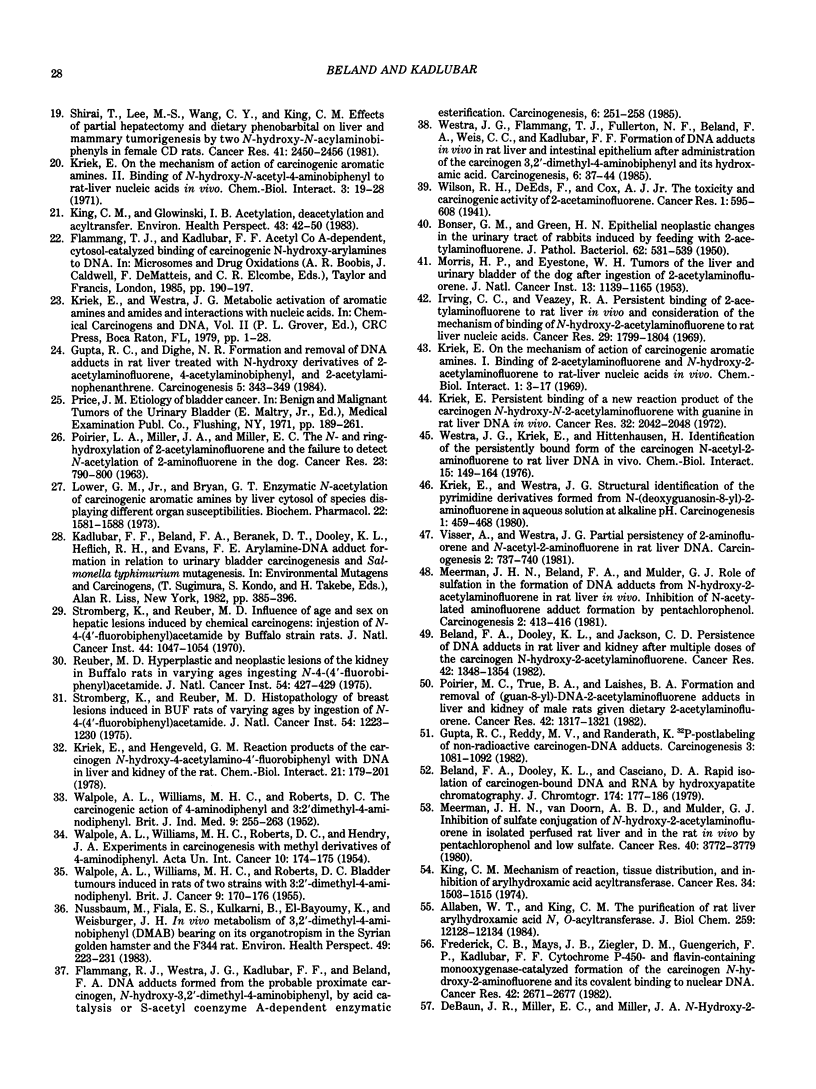
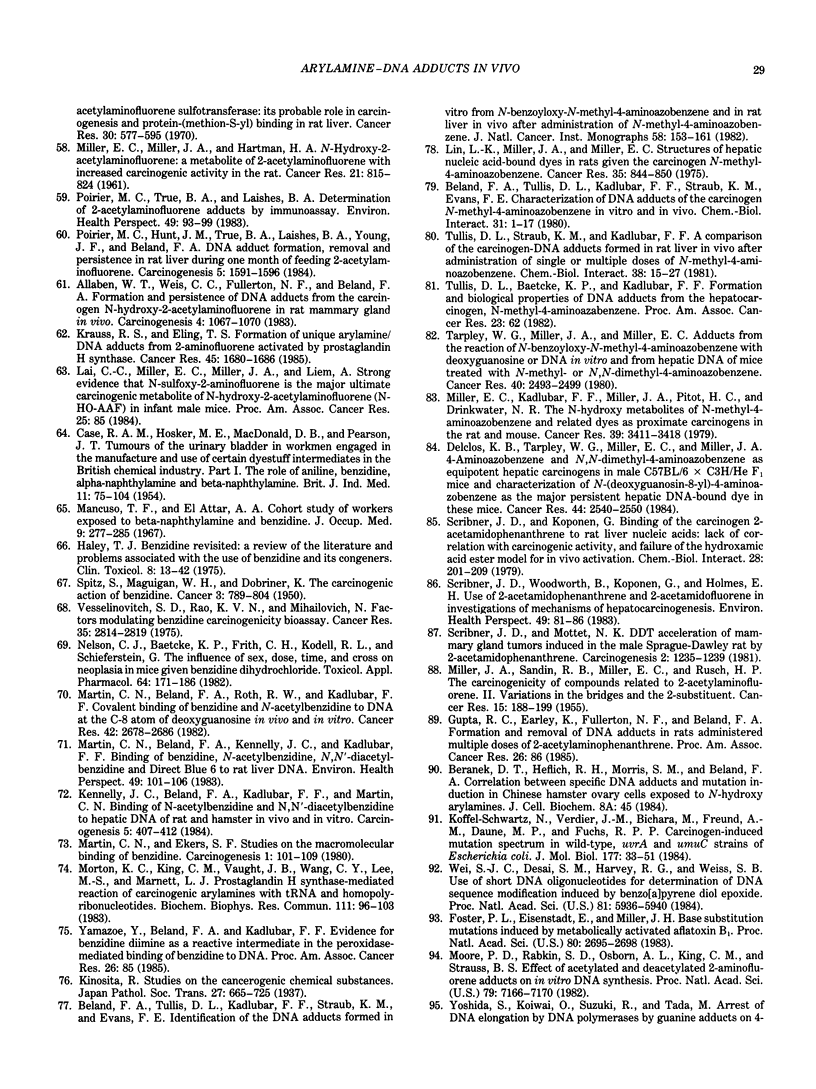
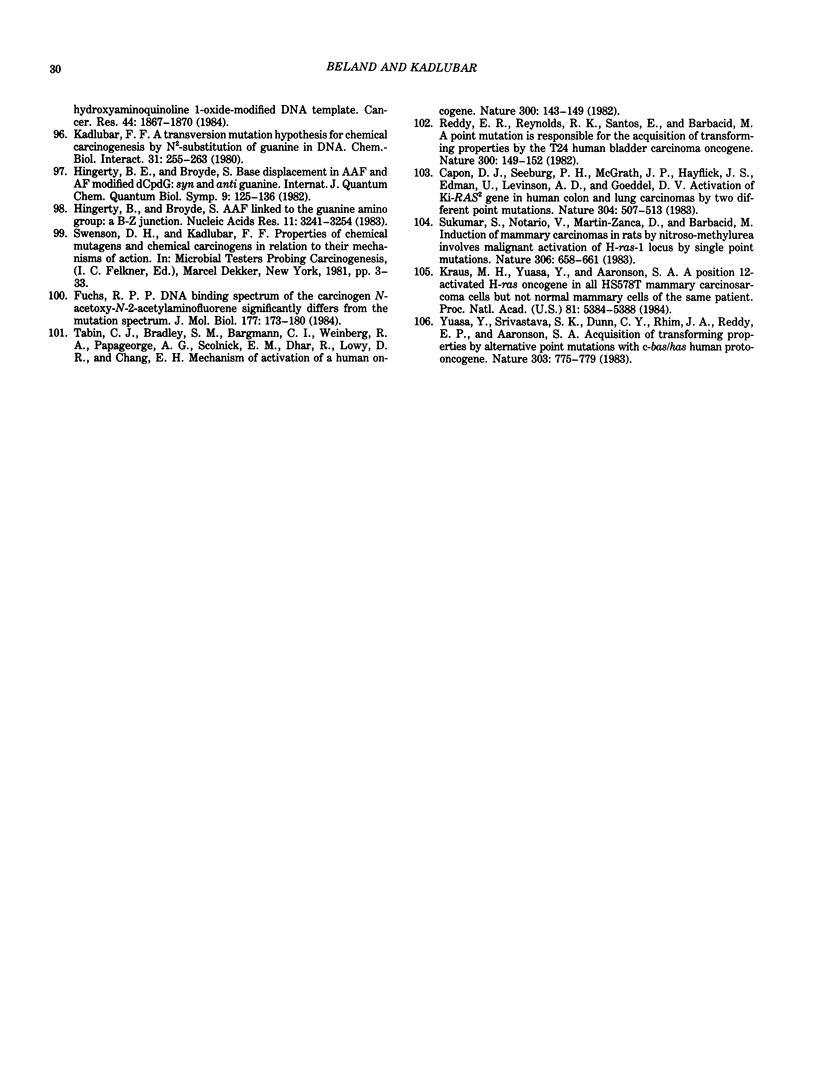
Selected References
These references are in PubMed. This may not be the complete list of references from this article.
- Allaben W. T., King C. M. The purification of rat liver arylhydroxamic acid N,O-acyltransferase. J Biol Chem. 1984 Oct 10;259(19):12128–12134. [PubMed] [Google Scholar]
- Allaben W. T., Weis C. C., Fullerton N. F., Beland F. A. Formation and persistence of DNA adducts from the carcinogen N-hydroxy-2-acetylaminofluorene in rat mammary gland in vivo. Carcinogenesis. 1983 Aug;4(8):1067–1070. doi: 10.1093/carcin/4.8.1067. [DOI] [PubMed] [Google Scholar]
- BONSER G. M., GREEN H. N. Epithelial neoplastic changes in the urinary tract of rabbits induced by feeding with 2-acetylaminofluorene. J Pathol Bacteriol. 1950 Oct;62(4):531–539. doi: 10.1002/path.1700620404. [DOI] [PubMed] [Google Scholar]
- Beland F. A., Beranek D. T., Dooley K. L., Heflich R. H., Kadlubar F. F. Arylamine-DNA adducts in vitro and in vivo: their role in bacterial mutagenesis and urinary bladder carcinogenesis. Environ Health Perspect. 1983 Mar;49:125–134. doi: 10.1289/ehp.8349125. [DOI] [PMC free article] [PubMed] [Google Scholar]
- Beland F. A., Dooley K. L., Casciano D. A. Rapid isolation of carcinogen-bound DNA and RNA by hydroxyapatite chromatography. J Chromatogr. 1979 Jun 1;174(1):177–186. doi: 10.1016/s0021-9673(00)87048-x. [DOI] [PubMed] [Google Scholar]
- Beland F. A., Dooley K. L., Jackson C. D. Persistence of DNA adducts in rat liver and kidney after multiple doses of the carcinogen N-hydroxy-2-acetylaminofluorene. Cancer Res. 1982 Apr;42(4):1348–1354. [PubMed] [Google Scholar]
- Belman S., Troll W., Teebor G., Mukai F. The carcinogenic and mutagenic properties of N-hydroxy-aminonaphthalenes. Cancer Res. 1968 Mar;28(3):535–542. [PubMed] [Google Scholar]
- CASE R. A., HOSKER M. E., McDONALD D. B., PEARSON J. T. Tumours of the urinary bladder in workmen engaged in the manufacture and use of certain dyestuff intermediates in the British chemical industry. I. The role of aniline, benzidine, alpha-naphthylamine, and beta-naphthylamine. Br J Ind Med. 1954 Apr;11(2):75–104. doi: 10.1136/oem.11.2.75. [DOI] [PMC free article] [PubMed] [Google Scholar]
- Capon D. J., Seeburg P. H., McGrath J. P., Hayflick J. S., Edman U., Levinson A. D., Goeddel D. V. Activation of Ki-ras2 gene in human colon and lung carcinomas by two different point mutations. Nature. 1983 Aug 11;304(5926):507–513. doi: 10.1038/304507a0. [DOI] [PubMed] [Google Scholar]
- DeBaun J. R., Miller E. C., Miller J. A. N-hydroxy-2-acetylaminofluorene sulfotransferase: its probable role in carcinogenesis and in protein-(methion-S-yl) binding in rat liver. Cancer Res. 1970 Mar;30(3):577–595. [PubMed] [Google Scholar]
- Delclos K. B., Tarpley W. G., Miller E. C., Miller J. A. 4-aminoazobenzene and N,N-dimethyl-4-aminoazobenzene as equipotent hepatic carcinogens in male C57BL/6 X C3H/He F1 mice and characterization of N-(Deoxyguanosin-8-yl)-4-aminoazobenzene as the major persistent hepatic DNA-bound dye in these mice. Cancer Res. 1984 Jun;44(6):2540–2550. [PubMed] [Google Scholar]
- Dooley K. L., Beland F. A., Bucci T. J., Kadlubar F. F. Local carcinogenicity, rates of absorption, extent and persistence of macromolecular binding, and acute histopathological effects of N-hydroxy-1-naphthylamine and N-hydroxy-2-naphthylamine. Cancer Res. 1984 Mar;44(3):1172–1177. [PubMed] [Google Scholar]
- Flammang T. J., Westra J. G., Kadlubar F. F., Beland F. A. DNA adducts formed from the probable proximate carcinogen, N-hydroxy-3,2' -dimethyl-4-aminobiphenyl, by acid catalysis or S-acetyl coenzyme A-dependent enzymatic esterification. Carcinogenesis. 1985 Feb;6(2):251–258. doi: 10.1093/carcin/6.2.251. [DOI] [PubMed] [Google Scholar]
- Foster P. L., Eisenstadt E., Miller J. H. Base substitution mutations induced by metabolically activated aflatoxin B1. Proc Natl Acad Sci U S A. 1983 May;80(9):2695–2698. doi: 10.1073/pnas.80.9.2695. [DOI] [PMC free article] [PubMed] [Google Scholar]
- Frederick C. B., Mays J. B., Ziegler D. M., Guengerich F. P., Kadlubar F. F. Cytochrome P-450- and flavin-containing monooxygenase-catalyzed formation of the carcinogen N-hydroxy-2-aminofluorene and its covalent binding to nuclear DNA. Cancer Res. 1982 Jul;42(7):2671–2677. [PubMed] [Google Scholar]
- Fuchs R. P. DNA binding spectrum of the carcinogen N-acetoxy-N-2-acetylaminofluorene significantly differs from the mutation spectrum. J Mol Biol. 1984 Jul 25;177(1):173–180. doi: 10.1016/0022-2836(84)90063-9. [DOI] [PubMed] [Google Scholar]
- Gupta R. C., Dighe N. R. Formation and removal of DNA adducts in rat liver treated with N-hydroxy derivatives of 2-acetylaminofluorene, 4-acetylaminobiphenyl, and 2-acetylaminophenanthrene. Carcinogenesis. 1984 Mar;5(3):343–349. doi: 10.1093/carcin/5.3.343. [DOI] [PubMed] [Google Scholar]
- Gupta R. C., Reddy M. V., Randerath K. 32P-postlabeling analysis of non-radioactive aromatic carcinogen--DNA adducts. Carcinogenesis. 1982;3(9):1081–1092. doi: 10.1093/carcin/3.9.1081. [DOI] [PubMed] [Google Scholar]
- Haley T. J. Benzidine revisited: a review of the literature and problems associated with the use of benzidine and its congeners. Clin Toxicol. 1975;8(1):13–42. doi: 10.3109/15563657508988044. [DOI] [PubMed] [Google Scholar]
- Hammons G. J., Guengerich F. P., Weis C. C., Beland F. A., Kadlubar F. F. Metabolic oxidation of carcinogenic arylamines by rat, dog, and human hepatic microsomes and by purified flavin-containing and cytochrome P-450 monooxygenases. Cancer Res. 1985 Aug;45(8):3578–3585. [PubMed] [Google Scholar]
- Hingerty B., Broyde S. AAF linked to the guanine amino group: a B-Z junction. Nucleic Acids Res. 1983 May 25;11(10):3241–3254. doi: 10.1093/nar/11.10.3241. [DOI] [PMC free article] [PubMed] [Google Scholar]
- Irving C. C., Veazey R. A. Persistent binding of 2-acetylaminofluorene to rat liver DNA in vivo and consideration of the mechanism of binding of N-hydroxy-2-acetylaminofluorene to rat liver nucleic acids. Cancer Res. 1969 Oct;29(10):1799–1804. [PubMed] [Google Scholar]
- Kadlubar F. F. A transversion mutation hypothesis for chemical carcinogenesis by N2-substitution of guanine in DNA. Chem Biol Interact. 1980 Sep;31(3):255–263. doi: 10.1016/0009-2797(80)90014-9. [DOI] [PubMed] [Google Scholar]
- Kadlubar F. F., Anson J. F., Dooley K. L., Beland F. A. Formation of urothelial and hepatic DNA adducts from carcinogen 2-naphthylamine. Carcinogenesis. 1981;2(5):467–470. doi: 10.1093/carcin/2.5.467. [DOI] [PubMed] [Google Scholar]
- Kadlubar F. F., Frederick C. B., Weis C. C., Zenser T. V. Prostaglandin endoperoxide synthetase-mediated metabolism of carcinogenic aromatic amines and their binding to DNA and protein. Biochem Biophys Res Commun. 1982 Sep 16;108(1):253–258. doi: 10.1016/0006-291x(82)91859-9. [DOI] [PubMed] [Google Scholar]
- Kadlubar F. F., Miller J. A., Miller E. C. Guanyl O6-arylamination and O6-arylation of DNA by the carcinogen N-hydroxy-1-naphthylamine. Cancer Res. 1978 Nov;38(11 Pt 1):3628–3638. [PubMed] [Google Scholar]
- Kadlubar F. F., Miller J. A., Miller E. C. Hepatic microsomal N-glucuronidation and nucleic acid binding of N-hydroxy arylamines in relation to urinary bladder carcinogenesis. Cancer Res. 1977 Mar;37(3):805–814. [PubMed] [Google Scholar]
- Kennelly J. C., Beland F. A., Kadlubar F. F., Martin C. N. Binding of N-acetylbenzidine and N,N'-diacetylbenzidine to hepatic DNA of rat and hamster in vivo and in vitro. Carcinogenesis. 1984 Mar;5(3):407–412. doi: 10.1093/carcin/5.3.407. [DOI] [PubMed] [Google Scholar]
- King C. M., Glowinski I. B. Acetylation, deacetylation and acyltransfer. Environ Health Perspect. 1983 Mar;49:43–50. doi: 10.1289/ehp.834943. [DOI] [PMC free article] [PubMed] [Google Scholar]
- King C. M. Mechanism of reaction, tissue distribution, and inhibition of arylhydroxamic acid acyltransferase. Cancer Res. 1974 Jun;34(6):1503–1515. [PubMed] [Google Scholar]
- Koffel-Schwartz N., Verdier J. M., Bichara M., Freund A. M., Daune M. P., Fuchs R. P. Carcinogen-induced mutation spectrum in wild-type, uvrA and umuC strains of Escherichia coli. Strain specificity and mutation-prone sequences. J Mol Biol. 1984 Jul 25;177(1):33–51. doi: 10.1016/0022-2836(84)90056-1. [DOI] [PubMed] [Google Scholar]
- Kraus M. H., Yuasa Y., Aaronson S. A. A position 12-activated H-ras oncogene in all HS578T mammary carcinosarcoma cells but not normal mammary cells of the same patient. Proc Natl Acad Sci U S A. 1984 Sep;81(17):5384–5388. doi: 10.1073/pnas.81.17.5384. [DOI] [PMC free article] [PubMed] [Google Scholar]
- Krauss R. S., Eling T. E. Formation of unique arylamine:DNA adducts from 2-aminofluorene activated by prostaglandin H synthase. Cancer Res. 1985 Apr;45(4):1680–1686. [PubMed] [Google Scholar]
- Kriek E., Hengeveld G. M. Reaction products of the carcinogen N-hydroxy-4-acetylamino-4'-fluorobiphenyl with DNA in liver and kidney of the rat. Chem Biol Interact. 1978 Jun;21(2-3):179–201. doi: 10.1016/0009-2797(78)90018-2. [DOI] [PubMed] [Google Scholar]
- Kriek E. On the mechanism of action of carcinogenic aromatic amines. I. Binding of 2-acetylaminofluorene and N-hydroxy-2-acetylaminofluorene to rat-liver nucleic acids in vivo. Chem Biol Interact. 1969 Oct;1(1):3–17. doi: 10.1016/0009-2797(69)90015-5. [DOI] [PubMed] [Google Scholar]
- Kriek E. On the mechanism of action of carcinogenic aromatic amines. II. Binding of N-hydroxy-N-acetyl-4-aminobiphenyl to rat-liver nucleic acids in vitro. Chem Biol Interact. 1971 Feb;3(1):19–28. doi: 10.1016/0009-2797(71)90023-8. [DOI] [PubMed] [Google Scholar]
- Kriek E. Persistent binding of a new reaction product of the carcinogen N-hydroxy-N-2-acetylaminofluorene with guanine in rat liver DNA in vivo. Cancer Res. 1972 Oct;32(10):2042–2048. [PubMed] [Google Scholar]
- Kriek E., Westra J. G. Structural identification of the pyrimidine derivatives formed from N-(deoxyguanosin-8-yl)-2-aminofluorene in aqueous solution at alkaline pH. Carcinogenesis. 1980 Jun;1(6):459–468. doi: 10.1093/carcin/1.6.459. [DOI] [PubMed] [Google Scholar]
- Lin J. K., Miller J. A., Miller E. C. Structures of hepatic nucleic acid-bound dyes in rats given the carcinogen N-methyl-4-aminoazobenzene. Cancer Res. 1975 Mar;35(3):844–850. [PubMed] [Google Scholar]
- Lower G. M., Jr, Bryan G. T. Enzymatic N-acetylation of carcinogenic aromatic amines by liver cytosol of species displaying different organ susceptibilities. Biochem Pharmacol. 1973 Jul 1;22(13):1581–1588. doi: 10.1016/0006-2952(73)90024-5. [DOI] [PubMed] [Google Scholar]
- MILLER E. C., MILLER J. A., HARTMANN H. A. N-Hydroxy-2-acetylaminofluorene: a metabolite of 2-acetylaminofluorene with increased carcinogenic activity in the rat. Cancer Res. 1961 Jul;21:815–824. [PubMed] [Google Scholar]
- MILLER J. A., SANDIN R. B., MILLER E. C., RUSCH H. P. The carcinogenicity of compounds related to 2-acetylaminofluorene. II. Variations in the bridges and the 2-substituent. Cancer Res. 1955 Mar;15(3):188–199. [PubMed] [Google Scholar]
- MORRIS H. P., EYESTONE W. H. Tumors of the liver and urinary bladder of the dog after ingestion of 2-acetylaminofluorene. J Natl Cancer Inst. 1953 Apr;13(5):1139–1165. [PubMed] [Google Scholar]
- Mancuso T. F., el-Attar A. A. Cohort study of workers exposed to betanaphthylamine and benzidine. J Occup Med. 1967 Jun;9(6):277–285. [PubMed] [Google Scholar]
- Martin C. N., Beland F. A., Kennelly J. C., Kadlubar F. F. Binding of benzidine, N-acetylbenzidine, N, N'-diacetylbenzidine and Direct Blue 6 to rat liver DNA. Environ Health Perspect. 1983 Mar;49:101–106. doi: 10.1289/ehp.8349101. [DOI] [PMC free article] [PubMed] [Google Scholar]
- Martin C. N., Beland F. A., Roth R. W., Kadlubar F. F. Covalent binding of benzidine and N-acetylbenzidine to DNA at the C-8 atom of deoxyguanosine in vivo and in vitro. Cancer Res. 1982 Jul;42(7):2678–2686. [PubMed] [Google Scholar]
- Meerman J. H., Beland F. A., Mulder G. J. Role of sulfation in the formation of DNA adducts from N-hydroxy-2-acetylaminofluorene in rat liver in vivo. Inhibition of N-acetylated aminofluorene adduct formation by pentachlorophenol. Carcinogenesis. 1981;2(5):413–416. doi: 10.1093/carcin/2.5.413. [DOI] [PubMed] [Google Scholar]
- Meerman J. H., van Doorn A. B., Mulder G. J. Inhibition of sulfate conjugation of N-hydroxy-2-acetylaminofluorene in isolated perfused rat liver and in the rat in vivo by pentachlorophenol and low sulfate. Cancer Res. 1980 Oct;40(10):3772–3779. [PubMed] [Google Scholar]
- Miller E. C., Kadlubar F. F., Miller J. A., Pitot H. C., Drinkwater N. R. The N-hydroxy metabolites of N-methyl-4-aminoazobenzene and related dyes as proximate carcinogens in the rat and mouse. Cancer Res. 1979 Sep;39(9):3411–3418. [PubMed] [Google Scholar]
- Miller J. A., Miller E. C. Some historical aspects of N-aryl carcinogens and their metabolic activation. Environ Health Perspect. 1983 Mar;49:3–12. doi: 10.1289/ehp.83493. [DOI] [PMC free article] [PubMed] [Google Scholar]
- Moore P. D., Rabkin S. D., Osborn A. L., King C. M., Strauss B. S. Effect of acetylated and deacetylated 2-aminofluorene adducts on in vitro DNA synthesis. Proc Natl Acad Sci U S A. 1982 Dec;79(23):7166–7170. doi: 10.1073/pnas.79.23.7166. [DOI] [PMC free article] [PubMed] [Google Scholar]
- Morton K. C., King C. M., Vaught J. B., Wang C. Y., Lee M. S., Marnett L. J. Prostaglandin H synthase-mediated reaction of carcinogenic arylamines with tRNA and homopolyribonucleotides. Biochem Biophys Res Commun. 1983 Feb 28;111(1):96–103. doi: 10.1016/s0006-291x(83)80122-3. [DOI] [PubMed] [Google Scholar]
- Murofushi Y., Hashimoto Y., Shudo K., Okamoto T. Reaction of 1-naphthylhydroxylamine with calf thymus deoxyribonucleic acid. Isolation and synthesis of N-(guanin-C8-yl)-1-naphthylamine. Chem Pharm Bull (Tokyo) 1981 Sep;29(9):2730–2732. doi: 10.1248/cpb.29.2730. [DOI] [PubMed] [Google Scholar]
- Nelson C. J., Baetcke K. P., Frith C. H., Kodell R. L., Schieferstein G. The influence of sex, dose, time, and cross on neoplasia in mice given benzidine dihydrochloride. Toxicol Appl Pharmacol. 1982 Jun 30;64(2):171–186. doi: 10.1016/0041-008x(82)90214-9. [DOI] [PubMed] [Google Scholar]
- Nussbaum M., Fiala E. S., Kulkarni B., El-Bayoumy K., Weisburger J. H. In vivo metabolism of 3,2'-dimethyl-4-aminobiphenyl (DMAB) bearing on its organotropism in the Syrian golden hamster and the F344 rat. Environ Health Perspect. 1983 Mar;49:223–231. doi: 10.1289/ehp.8349223. [DOI] [PMC free article] [PubMed] [Google Scholar]
- POIRIER L. A., MILLER J. A., MILLER E. C. The N- and ring-hydroxylation of 2-acetylaminofluorene and the failure to detect N-acetylation of 2-aminofluorene in the dog. Cancer Res. 1963 Jun;23:790–800. [PubMed] [Google Scholar]
- Poirier M. C., Hunt J. M., True B. A., Laishes B. A., Young J. F., Beland F. A. DNA adduct formation, removal and persistence in rat liver during one month of feeding 2-acetylaminofluorene. Carcinogenesis. 1984 Dec;5(12):1591–1596. doi: 10.1093/carcin/5.12.1591. [DOI] [PubMed] [Google Scholar]
- Poirier M. C., True B., Laishes B. A. Determination of 2-acetylaminofluorene adducts by immunoassay. Environ Health Perspect. 1983 Mar;49:93–99. doi: 10.1289/ehp.834993. [DOI] [PMC free article] [PubMed] [Google Scholar]
- Poirier M. C., True B., Laishes B. A. Formation and removal of (guan-8-yl)-DNA-2-acetylaminofluorene adducts in liver and kidney of male rats given dietary 2-acetylaminofluorene. Cancer Res. 1982 Apr;42(4):1317–1321. [PubMed] [Google Scholar]
- Purchase I. F., Kalinowski A. E., Ishmael J., Wilson J., Gore C. W., Chart I. S. Lifetime carcinogenicity study of 1- and 2-naphthylamine in dogs. Br J Cancer. 1981 Dec;44(6):892–901. doi: 10.1038/bjc.1981.289. [DOI] [PMC free article] [PubMed] [Google Scholar]
- Radomski J. L., Brill E., Deichmann W. B., Glass E. M. Carcinogenicity testing of N-hydroxy and other oxidation and decomposition products of 1- and 2-naphthylamine. Cancer Res. 1971 Oct;31(10):1461–1467. [PubMed] [Google Scholar]
- Radomski J. L., Deichmann W. B., Altman N. H., Radomski T. Failure of pure 1-naphthylamine to induce bladder tumors in dogs. Cancer Res. 1980 Oct;40(10):3537–3539. [PubMed] [Google Scholar]
- Radomski J. L. The primary aromatic amines: their biological properties and structure-activity relationships. Annu Rev Pharmacol Toxicol. 1979;19:129–157. doi: 10.1146/annurev.pa.19.040179.001021. [DOI] [PubMed] [Google Scholar]
- Reddy E. P., Reynolds R. K., Santos E., Barbacid M. A point mutation is responsible for the acquisition of transforming properties by the T24 human bladder carcinoma oncogene. Nature. 1982 Nov 11;300(5888):149–152. doi: 10.1038/300149a0. [DOI] [PubMed] [Google Scholar]
- Reuber M. D. Hyperplastic and neoplastic lesions of the kidney in Buffalo rats of varying ages ingesting N-4-(4'-flurobiphenyl)acetamide. J Natl Cancer Inst. 1975 Feb;54(2):427–429. doi: 10.1093/jnci/54.2.427. [DOI] [PubMed] [Google Scholar]
- SPITZ S., MAGUIGAN W. H., DOBRINER K. The carcinogenic action of benzidine. Cancer. 1950 Sep;3(5):789–804. doi: 10.1002/1097-0142(1950)3:5<789::aid-cncr2820030505>3.0.co;2-u. [DOI] [PubMed] [Google Scholar]
- Scribner J. D., Koponen G. Binding of the carcinogen 2-acetamidophenanthrene to rat liver nucleic acids: lack of correlation with carcinogenic activity, and failure of the hydroxamic acid ester model for in vivo activation. Chem Biol Interact. 1979 Dec;28(2-3):201–209. doi: 10.1016/0009-2797(79)90161-3. [DOI] [PubMed] [Google Scholar]
- Scribner J. D., Mottet N. K. DDT acceleration of mammary gland tumors induced in the male Sprague-Dawley rat by 2-acetamidophenanthrene. Carcinogenesis. 1981;2(12):1235–1239. doi: 10.1093/carcin/2.12.1235. [DOI] [PubMed] [Google Scholar]
- Scribner J. D., Woodworth B., Koponen G., Holmes E. H. Use of 2-acetamidophenanthrene and 2-acetamidofluorene in investigations of mechanisms of hepatocarcinogenesis. Environ Health Perspect. 1983 Mar;49:81–86. doi: 10.1289/ehp.834981. [DOI] [PMC free article] [PubMed] [Google Scholar]
- Shirai T., Lee M. S., Wang C. Y., King C. M. Effects of partial hepatectomy and dietary phenobarbital on liver and mammary tumorigenesis by two N-hydroxy-N-acylaminobiphenyls in female CD rats. Cancer Res. 1981 Jun;41(6):2450–2456. [PubMed] [Google Scholar]
- Stromberg K., Reuber M. D. Histopathology of breast lesions induced in BUF rats of varying ages by ingestion of N-4-(4'-fluorobiphenyl) acetamide. J Natl Cancer Inst. 1975 May;54(5):1223–1230. doi: 10.1093/jnci/54.5.1223. [DOI] [PubMed] [Google Scholar]
- Stromberg K., Reuber M. D. Influence of age and sex on hepatic lesions induced by chemical carcinogens: ingestion of N-4-(4'-fluorobiphenyl)acetamide by Buffalo strain rats. J Natl Cancer Inst. 1970 May;44(5):1047–1054. [PubMed] [Google Scholar]
- Sukumar S., Notario V., Martin-Zanca D., Barbacid M. Induction of mammary carcinomas in rats by nitroso-methylurea involves malignant activation of H-ras-1 locus by single point mutations. Nature. 1983 Dec 15;306(5944):658–661. doi: 10.1038/306658a0. [DOI] [PubMed] [Google Scholar]
- Tabin C. J., Bradley S. M., Bargmann C. I., Weinberg R. A., Papageorge A. G., Scolnick E. M., Dhar R., Lowy D. R., Chang E. H. Mechanism of activation of a human oncogene. Nature. 1982 Nov 11;300(5888):143–149. doi: 10.1038/300143a0. [DOI] [PubMed] [Google Scholar]
- Tarpley W. G., Miller J. A., Miller E. C. Adducts from the reaction of N-benzoyloxy-N-methyl-4-aminoazobenzene with deoxyguanosine or DNA in vitro and from hepatic DNA of mice treated with N-methyl- or N,N-dimethyl-4-aminoazobenzene. Cancer Res. 1980 Jul;40(7):2493–2499. [PubMed] [Google Scholar]
- Vesselinovitch S. D., Rao K. V., Mihailovich N. Factors modulating benzidine carcinogenicity bioassay. Cancer Res. 1975 Oct;35(10):2814–2819. [PubMed] [Google Scholar]
- Visser A., Westra J. G. Partial persistency of 2-aminofluorene and N-acetyl-2-aminofluorene in rat liver DNA. Carcinogenesis. 1981;2(8):737–740. doi: 10.1093/carcin/2.8.737. [DOI] [PubMed] [Google Scholar]
- WALPOLE A. L., WILLIAMS M. H. C., ROBERTS D. C. The carcinogenic action of 4-aminodiphenyl and 3:2'-dimethyl-4-amino-diphenyl. Br J Ind Med. 1952 Oct;9(4):255–263. doi: 10.1136/oem.9.4.255. [DOI] [PMC free article] [PubMed] [Google Scholar]
- WALPOLE A. L., WILLIAMS M. H., ROBERTS D. C. Bladder tumours induced in rats of two strains with 3:2'dimethyl-3-aminodiphenyl. Br J Cancer. 1955 Mar;9(1):170–176. doi: 10.1038/bjc.1955.13. [DOI] [PMC free article] [PubMed] [Google Scholar]
- WALPOLE A. L., WILLIAMS M. H., ROBERTS D. C., HENDRY J. A. Experiments in carcinogenesis with methyl derivates of 4-aminodiphenyl. Acta Unio Int Contra Cancrum. 1954;10(2):174–175. [PubMed] [Google Scholar]
- Wei S. J., Desai S. M., Harvey R. G., Weiss S. B. Use of short DNA oligonucleotides for determination of DNA sequence modifications induced by benzo[a]pyrene diol epoxide. Proc Natl Acad Sci U S A. 1984 Oct;81(19):5936–5940. doi: 10.1073/pnas.81.19.5936. [DOI] [PMC free article] [PubMed] [Google Scholar]
- Westra J. G., Flammang T. J., Fullerton N. F., Beland F. A., Weis C. C., Kadlubar F. F. Formation of DNA adducts in vivo in rat liver and intestinal epithelium after administration of the carcinogen 3,2'-dimethyl-4-aminobiphenyl and its hydroxamic acid. Carcinogenesis. 1985 Jan;6(1):37–44. doi: 10.1093/carcin/6.1.37. [DOI] [PubMed] [Google Scholar]
- Westra J. G., Kriek E., Hittenhausen H. Identification of the persistently bound form of the carcinogen N-acetyl-2-aminofluorene to rat liver DNA in vivo. Chem Biol Interact. 1976 Oct 2;15(2):149–164. doi: 10.1016/0009-2797(76)90160-5. [DOI] [PubMed] [Google Scholar]
- Wise R. W., Zenser T. V., Kadlubar F. F., Davis B. B. Metabolic activation of carcinogenic aromatic amines by dog bladder and kidney prostaglandin H synthase. Cancer Res. 1984 May;44(5):1893–1897. [PubMed] [Google Scholar]
- Young J. F., Kadlubar F. F. A pharmacokinetic model to predict exposure of the bladder epithelium to urinary N-hydroxyarylamine carcinogens as a function of urine pH, voiding interval, and resorption. Drug Metab Dispos. 1982 Nov-Dec;10(6):641–644. [PubMed] [Google Scholar]
- Yuasa Y., Srivastava S. K., Dunn C. Y., Rhim J. S., Reddy E. P., Aaronson S. A. Acquisition of transforming properties by alternative point mutations within c-bas/has human proto-oncogene. Nature. 1983 Jun 30;303(5920):775–779. doi: 10.1038/303775a0. [DOI] [PubMed] [Google Scholar]


